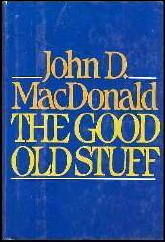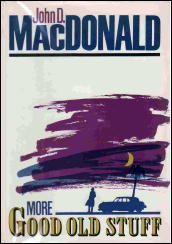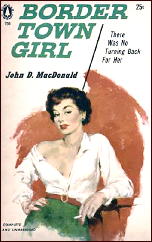Tue 24 Aug 2010
A 1001 MIDNIGHTS review: JOHN D. MacDONALD – The Good Old Stuff.
Posted by Steve under 1001 Midnights , Pulp Fiction , Reviews[2] Comments
by Bill Pronzini:

JOHN D. MacDONALD – The Good Old Stuff: 13 Early Stories. Harper & Row, hardcover, 1982. Fawcett Gold Medal, paperback, 1983.
MacDonald, like so many other writers, learned his craft in the pulps. Between 1946 and 1952, he sold hundreds of crime stories to such magazines as Black Mask, Dime Detective, Detective Tales, New Detective, Mystery Book, and Doc Savage (as well as other short fiction to science fiction, fantasy, sports, and western pulps).
A few of these criminous tales have been reprinted here and there over the years, but the greater percentage languished in (mostly undeserved) obscurity until 1981 , when Martin Greenberg, Francis M. Nevins, and Walter and Jean Shine — MacDonald aficionados all — persuaded John D. to collect the best of them.

They chose thirty stories; on rereading those thirty, MacDonald considered all but three worthy of reprinting. (Minor changes were made to update certain references for the sake of clarity; otherwise he allowed them to stand as first published.)
But the final total of twenty-seven was deemed too many for a single book; the result is two volumes — The Good Old Stuff and its companion, More Good Old Stuff (Knopf, 1984).
The thirteen stories in this first volume demonstrate MacDonald’s considerable range within the mystery! detective format, as well as his narrative talent and power. Among them are such gems as “The Simplest Poison” (whodunit); “Death Writes the Answer” (biter-bit); “Noose for a Tigress” (pure suspense); “Death on the Pin” (character study — and the world’s first and only crime story about bowling); and the novelette “Murder for Money,” whose protagonist, Darrigan, is a prototype of Travis McGee.

No fan of MacDonald’s work should miss either this batch or the fourteen equally excellent and diverse stories in More Good Old Stuff.
Until these volumes, MacDonald’s collected short fiction was restricted almost entirely to selections from such slick magazines as Cosmopolitan, Collier’s, and Playboy — fifteen stories in End of the Tiger (1966) and seven in Seven (1971).
His only previously collected pulp story was the title piece in the 1956 gathering of two novellas, Border Town Girl. Another two-story collection (both from the pulps), this one unauthorized, appeared in 1983 under the title Two.
———
Reprinted with permission from 1001 Midnights, edited by Bill Pronzini & Marcia Muller and published by The Battered Silicon Dispatch Box, 2007. Copyright © 1986, 2007 by the Pronzini-Muller Family Trust.
August 24th, 2010 at 7:10 pm
If anyone is allowed to update previously published stories, it has to be the author, but I sure wish MacDonald had decided not to. Mike Nevins has told me several times that they tried to talk him out of it, but JDM, of course, had the final say.
Most of the stories were published as is, but the one I remember as showing its seams the most was one that took place in a radio station — it was revised to take place in a TV studio instead. The problem was, as far as I was concerned, that while the setting was changed, the atmosphere was not.
— Steve
August 24th, 2010 at 7:20 pm
I can imagine writers wanting to tamper with their earlier work, but it is almost always a bad idea. Still, it’s better to have the stories than not have them, and in the case of a writer out of the pulps, the slicks, and paperback originals like JDM the urge to keep the work up to date may have been greater than he could resist.
At least he did it himself and not someone doing it for him.